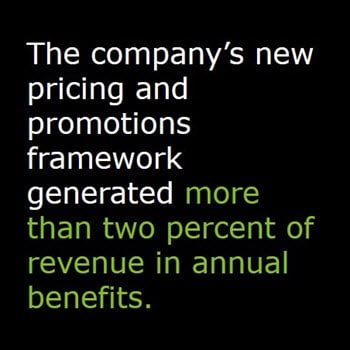Pricing to meet business and consumer demands has been saved

Perspectives
Pricing to meet business and consumer demands
Take three minutes to learn how analytics can help
What are five ways consumer products leaders gain more control over pricing? Take three minutes to give yourself a mini-crash course to learn how pricing analytics can help consumer products companies drive revenue and improve profits.
Aligning headquarters and sales
E-commerce, digital marketing and promotions, and new business models are creating more demanding, less brand-loyal consumers, requiring faster, smarter, more granular CP pricing.
Unfortunately, many sales and finance leaders still base pricing decisions on fragmented, outdated information, and sales often negotiate prices and discounts based on costs, competitive pressures, or gut instinct, usually at a banner or brand level.
It’s not because these leaders lack pricing-related information. What’s missing is the ability to easily tap granular insights from that data so that managers can make fast, fact-based decisions and sales representatives can easily access accurate, timely information to inform negotiations with clients.
How do you price to help retailers compete while meeting your company’s financial goals?
Lessons from consumer products leaders: Pricing analytics
Harmonize data to enable
Today’s CP companies are collecting far more than POS data. Instead, they’re collecting everything from enterprise data to promotional plans to consumer emails and tweets. Winning companies bring all these data together so that decision makers across the organization can access a common pool of information to improve consistency and accuracy.
Increase financial visibility
Leading companies are building capabilities to easily access detailed, granular information on demand—no data scientist and analyst needed—to answer revenue management questions: Do you know how much you make on each customer? Each store? Each product? Are discounts, defect allowances, and pickup allowances eroding your margins? Can you evaluate performance for each region against guidelines? What’s the ROI for last week’s promotion?
Make better-informed decisions
Similarly, leading companies are delivering
Set and monitor prices at scale
Thanks to analytics technology platforms that
Improve communications with easy-to-grasp visuals
Revenue management analytics are no longer just for the data scientists with advanced degrees. Modern visualization techniques can simplify the presentation of information through intuitive, user-friendly dashboards, while analytics tools are increasingly linking analytics to business processes, providing users with the facts and context to make better-informed decisions. Winning companies also use these visualization tools to present and customize new opportunities to their retailers and distributors.
Consumer Products pricing analytics in action
A multibillion-dollar global food ingredients company needed to make better-informed pricing decisions. Account managers made quotes solely on gut feeling and personal experience, without support from
The company implemented an analytics solution that generated price targets at the customer and product levels. The solution provided quantitative insights that account managers used to communicate the value of their products and services to customers. The solution also enabled “what-if” scenario planning to improve negotiations and profits.
The results? The company’s new pricing and promotions framework generated more than two percent of revenue in annual benefits.

PolarisTM: Insight-driven revenue management
If you’re looking for persona–driven usability, guided decision workflows, and interactive data visualizations, click here to learn more about Polaris.



